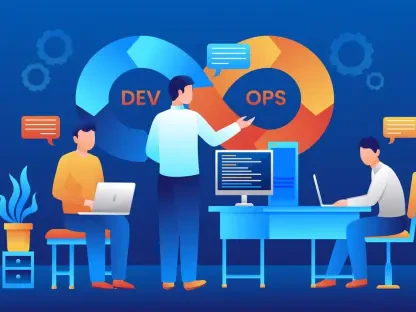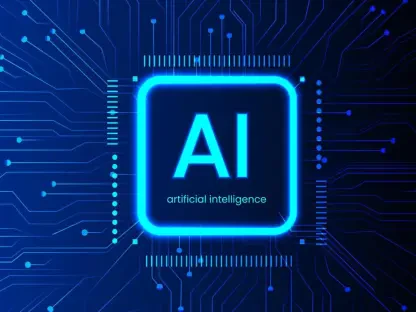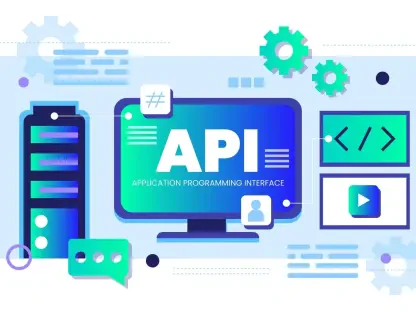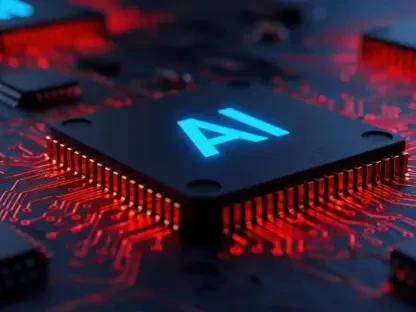The landscape of software development is undergoing a seismic shift as artificial intelligence (AI) becomes an integral part of coding processes, promising unprecedented productivity while simultaneously unveiling complex security challenges that demand urgent attention. A staggering 100% of organizations now have AI-generated code in production environments, a statistic that underscores the rapid and pervasive integration of AI tools across the industry. This transformative technology is reshaping how software is built, yet it also raises critical questions about risk management and oversight. As companies race to leverage AI for competitive advantage, the balance between innovation and security emerges as a defining issue for the sector.
The Rise of AI in Software Development
AI’s integration into software development has reached a near-universal scale, with organizations of all sizes adopting these tools to enhance their capabilities. According to a comprehensive industry report, every surveyed company currently utilizes AI-generated code in production, while 97% are either actively using or piloting AI coding assistants. This widespread adoption reflects a fundamental shift in how development teams operate, moving away from traditional manual coding to automated, intelligent systems that promise to redefine efficiency standards.
Beyond mere adoption, AI’s impact is particularly pronounced in mid-sized companies, where it serves as a force multiplier for smaller teams. These organizations often rely on AI to bridge resource gaps, enabling them to compete with larger counterparts by accelerating project timelines. The technology’s ability to streamline workflows and reduce repetitive tasks has positioned it as a cornerstone of modern development strategies, driving significant improvements in productivity.
A key driver of AI’s appeal is its capacity to shorten time-to-market, a critical metric for businesses in a fast-paced digital economy. By automating complex coding tasks and offering real-time suggestions, AI empowers developers to focus on innovation rather than routine processes. This trend is reshaping organizational priorities, with many firms citing faster delivery cycles as a primary benefit of AI integration, setting the stage for a new era of software creation.
Productivity Gains and Emerging Trends in AI-Driven Development
Key Benefits and Industry Trends
AI’s influence on developer efficiency cannot be overstated, with 72% of organizations reporting a marked reduction in time-to-market due to these tools. This acceleration is not merely a byproduct of automation but a result of AI’s ability to handle intricate coding challenges with precision. From generating code snippets to debugging errors, AI assistants are becoming indispensable allies for developers striving to meet tight deadlines.
Another notable trend is the growing dependence on AI for substantial portions of coding needs. Approximately one in three organizations now relies on AI to produce the majority of their code, a shift that highlights the technology’s evolving role from a supplementary tool to a core component of development pipelines. This reliance is fostering a culture of innovation, as teams experiment with AI-driven approaches to tackle complex projects.
The broader implications of these trends point to a fundamental transformation in development practices. AI is not just enhancing existing processes but also inspiring new methodologies that prioritize speed and scalability. As the industry continues to embrace these tools, the potential for groundbreaking advancements in software creation becomes increasingly apparent, promising to redefine competitive landscapes.
Data Insights and Future Outlook
Delving into specific data, the adoption rates of AI tools reveal a trajectory of rapid growth, with nearly all surveyed entities integrating these solutions into their workflows. Productivity metrics further validate this trend, showing consistent improvements in developer output and project turnaround times. Such figures emphasize the tangible benefits that AI brings to the table, cementing its status as a game-changer in software development.
Looking ahead, projections suggest that AI will further revolutionize development pipelines by enabling greater scalability and operational efficiency. Over the next few years, from 2025 to 2027, the industry is expected to witness deeper integration of AI tools into every stage of the software lifecycle. This evolution will likely open up opportunities for organizations to handle larger, more complex projects with fewer resources.
Moreover, the future of AI in development may see these tools becoming even more seamlessly embedded into workflows, with advancements in natural language processing and machine learning enhancing their capabilities. As AI systems grow more intuitive, they could anticipate developer needs, further reducing friction in the coding process. This forward-looking perspective highlights a horizon rich with potential for those ready to adapt.
Security Challenges in the AI Era
The rapid adoption of AI in software development, while transformative, has introduced significant security risks that cannot be ignored. A concerning 65% of organizations report an increase in overall risk since incorporating AI into their processes, a statistic that reflects the darker side of this technological revolution. These risks stem from the very nature of AI-generated outputs, which can sometimes be difficult to predict or control.
One of the most pressing issues is the lack of visibility into AI-generated code, with only 19% of organizations claiming complete oversight over where and how AI is applied in their systems. This opacity creates vulnerabilities, as AI can inadvertently introduce logic flaws or insecure coding patterns that spread rapidly through codebases. Without proper monitoring, such issues risk compromising the integrity of entire applications.
Additionally, the phenomenon of “shadow AI” exacerbates these challenges, as unapproved tools and plugins are often used by employees without formal oversight. This expands the attack surface, exposing sensitive data to potential breaches outside established security frameworks. To counter this, enhanced monitoring and stricter approval processes are essential, alongside educating teams about the risks of unauthorized AI usage, ensuring a more secure development environment.
Governance and Compliance Gaps in AI Integration
The integration of AI into software development has also exposed significant gaps in governance, with over half of surveyed organizations lacking centralized policies for AI usage. This absence of structured oversight leads to fragmented approval processes and accountability challenges, making it difficult to enforce consistent standards across teams. Such gaps pose a substantial barrier to safe and responsible AI adoption.
Security teams are increasingly stepping into regulatory roles to address these deficiencies, often adopting innovative measures like AI bills of materials to document models, datasets, and dependencies. This approach, inspired by software bills of materials, aims to enhance transparency and traceability in AI-driven processes. However, without broader industry consensus, these efforts risk remaining isolated rather than systemic solutions.
Historically, governance inconsistencies have mirrored security weaknesses that led to major incidents, and the current landscape with AI shows similar patterns. The urgent need for standardized compliance frameworks is evident, as they would provide a foundation for ensuring safety while fostering innovation. Until such frameworks are widely adopted, organizations must prioritize internal policies to mitigate risks associated with unregulated AI use.
Future Directions: Balancing Innovation with Security
The tension between productivity gains and escalating security risks remains a central challenge in the AI-driven software landscape. Business leaders often prioritize speed to capitalize on AI’s benefits, sometimes at the expense of robust security controls. This short-term focus could have long-term implications, as vulnerabilities accumulate alongside accelerated development cycles, threatening overall system stability.
Emerging solutions, such as the convergence and consolidation of security tools, offer a path forward, with 97% of organizations planning to simplify their application security stacks in the near term. This trend toward streamlined systems aims to reduce tool sprawl, which has long complicated security management. By integrating disparate functions into unified platforms, companies can enhance visibility and prioritize critical risks more effectively.
Growth areas like unified security frameworks are poised to play a pivotal role in aligning speed with control. These frameworks, which combine application security testing, supply chain security, and posture management, promise a holistic approach to safeguarding AI-driven development. As the industry evolves, investing in such comprehensive solutions will be crucial for maintaining a competitive edge while addressing the inherent risks of AI adoption.
Conclusion: Navigating the AI-Driven Software Landscape
Reflecting on the insights gathered, it becomes clear that AI has established itself as both a transformative force and a source of substantial security challenges within software development. The near-universal adoption of AI tools has delivered undeniable productivity benefits, yet critical blind spots in visibility and governance persist as significant hurdles. These findings underscore the complexity of integrating cutting-edge technology into established workflows.
Looking back, the dual nature of AI’s impact has necessitated a strategic response from industry stakeholders. Actionable next steps include prioritizing enhanced oversight mechanisms to address visibility gaps and implementing robust governance structures to ensure accountability. Organizations are encouraged to explore integrated security approaches, such as unified frameworks, to balance innovation with risk management effectively.
Beyond immediate actions, future considerations revolve around fostering industry-wide collaboration to develop standardized compliance protocols. Such efforts aim to mitigate the risks of shadow AI and supply chain vulnerabilities while supporting sustainable progress. As the software development landscape continues to evolve, these proactive measures lay the groundwork for a more secure and innovative future in the AI era.









